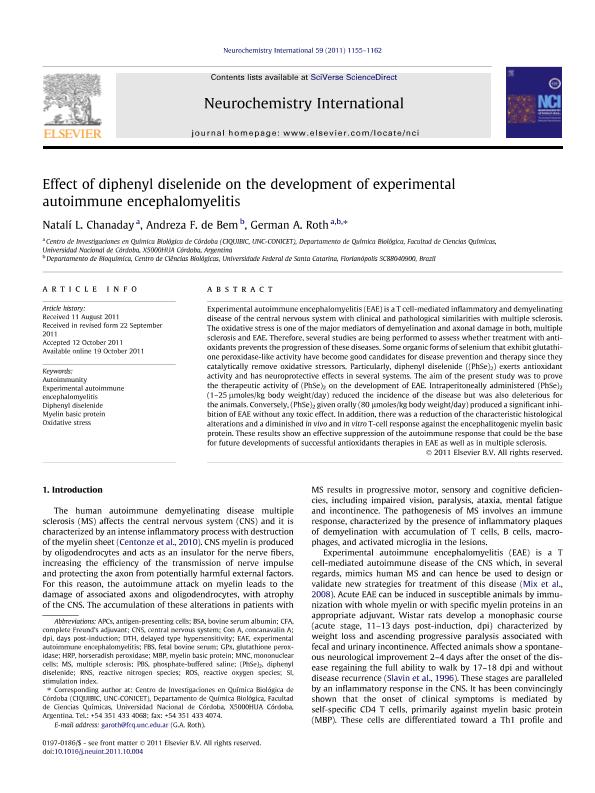Mostrar el registro sencillo del ítem
dc.contributor.author
Chanaday Ricagni, Natalí Luján

dc.contributor.author
Andreza, Fabro de Bem
dc.contributor.author
Roth, German Alfredo

dc.date.available
2024-03-07T13:10:35Z
dc.date.issued
2011-10
dc.identifier.citation
Chanaday Ricagni, Natalí Luján; Andreza, Fabro de Bem; Roth, German Alfredo; Effect of diphenyl diselenide on the development of experimental autoimmune encephalomyelitis; Pergamon-Elsevier Science Ltd; Neurochemistry International; 59; 8; 10-2011; 1155-1162
dc.identifier.issn
0197-0186
dc.identifier.uri
http://hdl.handle.net/11336/229705
dc.description.abstract
Experimental autoimmune encephalomyelitis (EAE) is a T cell-mediated inflammatory and demyelinating disease of the central nervous system with clinical and pathological similarities with multiple sclerosis. The oxidative stress is one of the major mediators of demyelination and axonal damage in both, multiple sclerosis and EAE. Therefore, several studies are being performed to assess whether treatment with antioxidants prevents the progression of these diseases. Some organic forms of selenium that exhibit glutathione peroxidase-like activity have become good candidates for disease prevention and therapy since they catalytically remove oxidative stressors. Particularly, diphenyl diselenide ((PhSe)2) exerts antioxidant activity and has neuroprotective effects in several systems. The aim of the present study was to prove the therapeutic activity of (PhSe)2 on the development of EAE. Intraperitoneally administered (PhSe)2 (1–25 lmoles/kg body weight/day) reduced the incidence of the disease but was also deleterious for the animals. Conversely, (PhSe)2 given orally (80 lmoles/kg body weight/day) produced a significant inhibition of EAE without any toxic effect. In addition, there was a reduction of the characteristic histological alterations and a diminished in vivo and in vitro T-cell response against the encephalitogenic myelin basic protein. These results show an effective suppression of the autoimmune response that could be the base for future developments of successful antioxidants therapies in EAE as well as in multiple sclerosis.
dc.format
application/pdf
dc.language.iso
eng
dc.publisher
Pergamon-Elsevier Science Ltd

dc.rights
info:eu-repo/semantics/openAccess
dc.rights.uri
https://creativecommons.org/licenses/by-nc-sa/2.5/ar/
dc.subject
Diselenide
dc.subject
Encephalomyelitis
dc.subject
Myelin
dc.subject
Glutamate
dc.subject.classification
Neurociencias

dc.subject.classification
Medicina Básica

dc.subject.classification
CIENCIAS MÉDICAS Y DE LA SALUD

dc.title
Effect of diphenyl diselenide on the development of experimental autoimmune encephalomyelitis
dc.type
info:eu-repo/semantics/article
dc.type
info:ar-repo/semantics/artículo
dc.type
info:eu-repo/semantics/publishedVersion
dc.date.updated
2024-03-05T13:22:26Z
dc.identifier.eissn
1872-9754
dc.journal.volume
59
dc.journal.number
8
dc.journal.pagination
1155-1162
dc.journal.pais
Estados Unidos

dc.description.fil
Fil: Chanaday Ricagni, Natalí Luján. Universidad Nacional de Córdoba. Facultad de Ciencias Químicas. Departamento de Química Biológica; Argentina. Consejo Nacional de Investigaciones Científicas y Técnicas. Centro Científico Tecnológico Conicet - Córdoba. Centro de Investigaciones en Química Biológica de Córdoba. Universidad Nacional de Córdoba. Facultad de Ciencias Químicas. Centro de Investigaciones en Química Biológica de Córdoba; Argentina
dc.description.fil
Fil: Andreza, Fabro de Bem. Universidade Federal de Santa Catarina; Brasil
dc.description.fil
Fil: Roth, German Alfredo. Universidad Nacional de Córdoba. Facultad de Ciencias Químicas. Departamento de Química Biológica; Argentina. Consejo Nacional de Investigaciones Científicas y Técnicas. Centro Científico Tecnológico Conicet - Córdoba. Centro de Investigaciones en Química Biológica de Córdoba. Universidad Nacional de Córdoba. Facultad de Ciencias Químicas. Centro de Investigaciones en Química Biológica de Córdoba; Argentina
dc.journal.title
Neurochemistry International

dc.relation.alternativeid
info:eu-repo/semantics/altIdentifier/doi/http://dx.doi.org/10.1016/j.neuint.2011.10.004
dc.relation.alternativeid
info:eu-repo/semantics/altIdentifier/url/https://www.sciencedirect.com/science/article/pii/S0197018611003366
Archivos asociados
